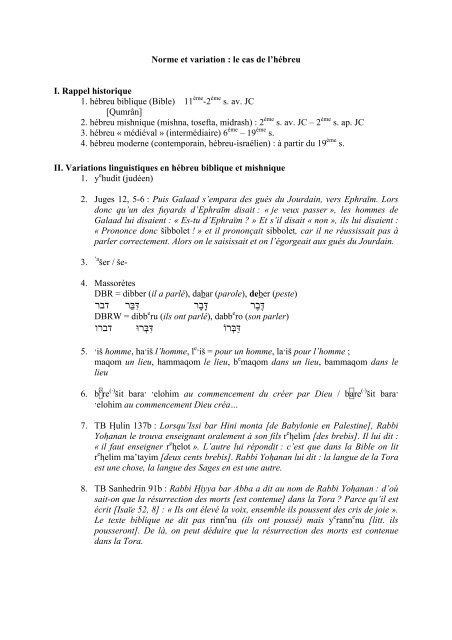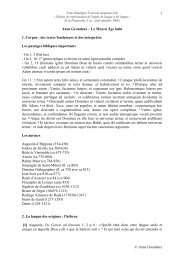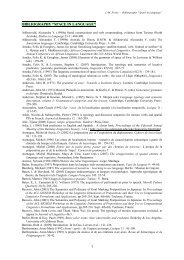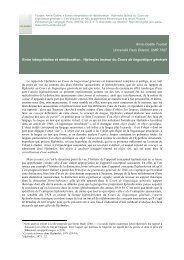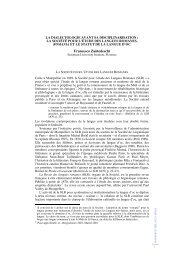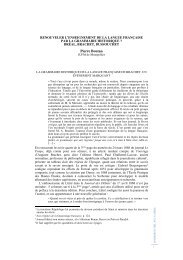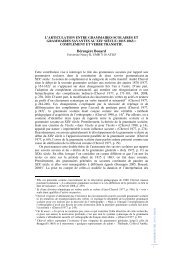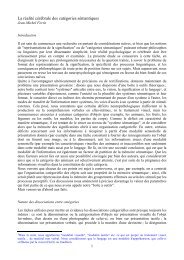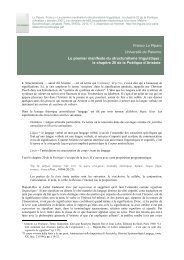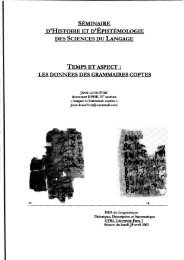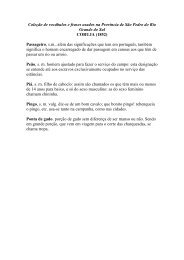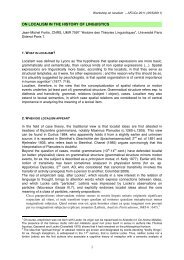exemplier - Histoire des théories linguistiques
exemplier - Histoire des théories linguistiques
exemplier - Histoire des théories linguistiques
You also want an ePaper? Increase the reach of your titles
YUMPU automatically turns print PDFs into web optimized ePapers that Google loves.
Norme et variation : le cas de l’hébreu<br />
I. Rappel historique<br />
1. hébreu biblique (Bible) 11 ème -2 ème s. av. JC<br />
[Qumrân]<br />
2. hébreu mishnique (mishna, tosefta, midrash) : 2 ème s. av. JC – 2 ème s. ap. JC<br />
3. hébreu « médiéval » (intermédiaire) 6 ème – 19 ème s.<br />
4. hébreu moderne (contemporain, hébreu-israélien) : à partir du 19 ème s.<br />
II. Variations <strong>linguistiques</strong> en hébreu biblique et mishnique<br />
1. y e hudit (judéen)<br />
2. Juges 12, 5-6 : Puis Galaad s’empara <strong>des</strong> gués du Jourdain, vers Ephraïm. Lors<br />
donc qu’un <strong>des</strong> fuyards d’Ephraïm disait : « je veux passer », les hommes de<br />
Galaad lui disaient : « Es-tu d’Ephraïm ? » Et s’il disait « non », ils lui disaient :<br />
« Prononce donc šibbolet ! » et il prononçait sibbolet, car il ne réussissait pas à<br />
parler correctement. Alors on le saisissait et on l’égorgeait aux gués du Jourdain.<br />
3. ’a šer / še-<br />
4. Massorètes<br />
DBR = dibber (il a parlé), dabar (parole), deber (peste)<br />
רבד רֵבִּדּ רָבָדּ רֶבֶדּ<br />
DBRW = dibb e ru (ils ont parlé), dabb e ro (son parler)<br />
ורבד וּרְבִּדּ וֹרְבַּדּ<br />
5. ’iš homme, ha’iš l’homme, l e ’iš = pour un homme, la’iš pour l’homme ;<br />
maqom un lieu, hammaqom le lieu, b e maqom dans un lieu, bammaqom dans le<br />
lieu<br />
6. b e re ( ’) šit bara’ ’elohim au commencement du créer par Dieu / bare ( ’) šit bara’<br />
’elohim au commencement Dieu créa…<br />
7. TB Hulin 137b : Lorsqu’Issi bar Hini monta [de Babylonie en Palestine], Rabbi<br />
Yohanan le trouva enseignant oralement à son fils r e helim [<strong>des</strong> brebis]. Il lui dit :<br />
« il faut enseigner r e helot ». L’autre lui répondit : c’est que dans la Bible on lit<br />
r e helim ma’tayim [deux cents brebis]. Rabbi Yohanan lui dit : la langue de la Tora<br />
est une chose, la langue <strong>des</strong> Sages en est une autre.<br />
8. TB Sanhedrin 91b : Rabbi Hiyya bar Abba a dit au nom de Rabbi Yohanan : d’où<br />
sait-on que la résurrection <strong>des</strong> morts [est contenue] dans la Tora ? Parce qu’il est<br />
écrit [Isaïe 52, 8] : « Ils ont élevé la voix, ensemble ils poussent <strong>des</strong> cris de joie ».<br />
Le texte biblique ne dit pas rinn e nu (ils ont poussé) mais y e rann e nu [litt. ils<br />
pousseront]. De là, on peut déduire que la résurrection <strong>des</strong> morts est contenue<br />
dans la Tora.
III. Influence de l’hébreu biblique sur l’hébreu mishnique<br />
1. ’anahnu / ’anu<br />
2. L’KL = Le’eKoL / Lo ( ’) KaL<br />
futur infinitif biblique infinitif mishnique<br />
y e dabber l e dabber l e dabber<br />
yitten latet litten<br />
yo ( ’) kal le’ekol lo ( ’) kal<br />
IV. Hébreu moderne<br />
1. Prononciation ashkénaze / séfarade / yéménite.<br />
2. S. Morag, 1959 : After many centuries of semi-fossilized existence, Hebrew has<br />
regained its normality. The development of the re-created language, Modern<br />
Hebrew, is in certain respects a phenomenon which is of interest to the general<br />
linguist. Aspects of planned versus unplanned development in the domain of<br />
phonology, morphology, and vocabulary are here <strong>des</strong>cribed, in an attempt to<br />
clarify the relationship between the new constituents of Modern Hebrew, the<br />
products of recent processes of evolution, and the old constituents, which are<br />
legacies of the past.<br />
3. ‘or, peau; ’or, lumière = or<br />
4. /b/ /g/ /d/ /k/ /p/ /t/<br />
/v/ /x/ /f/<br />
kol maqom / l e xol maqom ; biker / m e vaker ; tafar / litpor.<br />
sport ; film ; disk ; fobiya ; l e hitxaber (l e hithabber), s’associer à /l e hitxaver, devenir<br />
ami avec (< xaver)<br />
5. *b e- t e verya > bitverya (à Tibériade)<br />
w e = et; w e david et David mais ušlomo (< w u šlomo) / vešlomo<br />
6. Moshé Nahir (1978): Descriptive grammars and studies in standard Modern<br />
Hebrew are even fewer (in contrast with the abundance of prescriptive work). Of<br />
these most are based, as elsewhere on the investigator’s intuition about the<br />
language, although a slight change in direction may be observed […]. As regards<br />
Hebrew textbooks used in Israeli schools, virtually all are prescriptive and<br />
normative in their approach. This has been justified by the claim that since the<br />
Hebrew vernacular was revived less than a century ago it still needs “guidance”<br />
by the “experts”, as Abba Bendavid, one of the leading proponents of normativism<br />
in Hebrew puts it [en 1967, SKM] : “the relationship between the question what<br />
current standard Hebrew is and what its <strong>des</strong>ired norm ought to be in the future is<br />
necessarily the reverse of the situation in other nations: in other languages the<br />
standard […] brings out the establishment of a norm […] This is not so in Hebrew,<br />
where in order to revive the language it is the norm which builds up the standard;<br />
it is the will which creates reality”.<br />
p. 374 (conclusion): A study on language normativism compared with actual usage<br />
should expect to be criticized for contributing gowards the legitimization of “street<br />
language”. This has not been the objective of this study, nor has it been to
contribute towards the abolition of the concept of ‘mistake’. What has been<br />
attempted in this study, rather, is to esyablish whether there exists any speech<br />
group within the Hebrew speech community whose linguistic inventory include the<br />
norms investigated above.<br />
7. tisgor et adelet (ferme la porte) > tsgor tadelet > sgortadelet [sgor]<br />
[futur] [impératif]<br />
tikansi abayta (rentre [fém.] à la maison) > tkansi abayta > kansi abayta [kansi,<br />
non hikan e si, impératif]<br />
tišt e ki > št e ki (et non šitki, impératif).<br />
lehavi, apporter > lavi = HB (Jér 39, 7)<br />
lehikanes, entrer > likanes = HM<br />
8. maqle‘a mitrailleuse, plur. maql e ‘im > maql e ‘an mitrailleur<br />
mišpat droit, plur. mišpatim > mišpatan, juriste.<br />
pluriel : maql e ‘anim, mišp e tanim<br />
mišpatan, mišpatanim OU mišp e tan, mišp e tanim<br />
Bibliographie<br />
Bentolila Yaakov, “Linguistic Variation across generations in Israel”, B. Hary (éd.),<br />
Corpus Linguistics and Modern Hebrew, Tel-Aviv, 2003, p. 105-117.<br />
Blanc Hayyim, “Israeli Hebrew Texts”, Studies in Egyptology and Linguistics in Honour<br />
of H. J. Polotsky, Jérusalem, 1964, p. 132-152.<br />
Bolozky Shmuel, “Phonological and morphological variation in spoken Hebrew”, B. Hary<br />
(éd.), Corpus Linguistics and Modern Hebrew, Tel-Aviv, 2003, p. 119-156.<br />
Hadas-Lebel Mireille, L’hébreu : 3000 ans d’histoire, Paris, Albin Michel.<br />
Izre’el Shlomo, « The Emergence of Spoken Israeli Hebrew », B. Hary (éd.), Corpus<br />
Linguistics and Modern Hebrew, Tel-Aviv, 2003, p. 85-104.<br />
Kessler-Mesguich Sophie, La langue <strong>des</strong> Sages, matériaux pour une étude linguistique de<br />
l’hébreu de la Mishna, Peeters, Paris-Louvain, 2002.<br />
Kessler-Mesguich Sophie, « L’Académie de la langue hébraïque et la morphologie de<br />
l’hébreu contemporain », B. Kaltz (éd.), Regards croisés sur les mots non simples, Actes<br />
du colloque d’Aix en Provence, à par. aux Presses de l’ENS en 2008.<br />
Morag Shlomo, « Planned and unplanned development in Modern Hebrew », Lingua 8<br />
(1959), p. 247-263.<br />
Nahir Moshé, “Normativism and educated speech in Modern Hebrew”, International<br />
Journal for the Sociology of Language 18 (1978), p. 49-67.<br />
Rosén Hayyim B., Contemporary Hebrew, The Hague/ Paris, Mouton, 1977.<br />
Sáenz-Badillos Angel, A History of the Hebrew Language, Cambridge University Press,<br />
1993 (trad. de Historia de la lengua Hebrea, Sabadell 1988)<br />
Schwarzwald (Rodrigue) Ora, Grammar and reality in the Hebrew verb, Bar-Ilan<br />
University Press, 1981 (en hébreu).<br />
Schwarzwald (Rodrigue) Ora, “ Language varieties in contemporary Hebrew”, S. Izre’el<br />
(ed.), Speaking Hebrew, Studies in the Spoken LZnguage and in Linguistic Variation in<br />
Israel, Tel-Aviv University, 2002 (Te‘uda XVIII), p. 141-175 (en hébreu).


